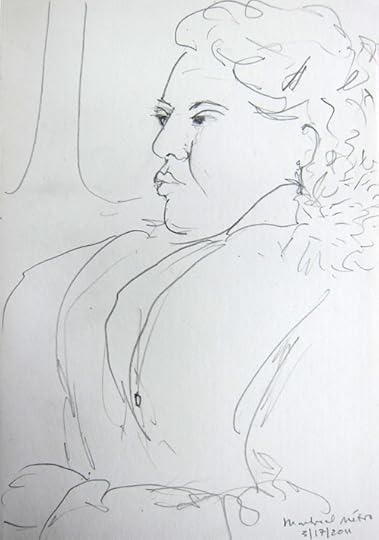Sketching
This woman was on the metro recently, and I couldn't resist drawing her beautiful face and hair, set off by a big parka with a fur collar.
During the intermission of the concert I wrote about earlier this week, I had time to do a few sketches of other concertgoers nearby.
This elderly lady had a very thin face, and lots of lovely hair. She was all dressed up in her fancy glasses and pearls, and an elegant teal-colored dress, and she had a serenity that attracted me.
This couple was standing, talking to friends, at intermission. The woman kept moving but I was determined to draw her; she had beautiful black hair, a great face, and a fabulous black matador jacket with gold embroidery worn over corduroy pants. Her companion was as impassive as she was expressive.
---
It was last May when I started drawing again, after so many years of not. And although I haven't drawn every day, I've tried to keep at it. It makes me happy to see the practice paying off in greater ease, quickness, and assurance, just like it can with an instrument, a language, or a sport. With drawing, you are training not only your hand but your eye. This kind of fast drawing, of people or animals, is one of the best ways to improve because even if they're not moving right now, they will soon! You can't spend a lot of time being careful, you have to just look - memorize - quickly put it down - look again - and so on. And you have to learn what is essential in capturing a likeness - the shapes and angles formed by the bones of the face, the relative position of the features, the shape of the eyes and mouth, and the particular aspect of a person that helps give their "essence" and may be what attracted you in the first place: their hair, the hat they're wearing, their wild eyebrows, big sensuous mouth, their interesting posture, or whatever. All this thinking and decision-making needs to happen quickly, which is hard at first -- but what's gratifying is that it really does get easier.
And it's interesting to keep the work and go back to it after a while, because you are also learning to see its strengths and weaknesses, what could be improved, and how your line gradually becomes more assured. There's no substitute for practice.
I've been drawing, off and on, all my life, but I've always been too careful. When I started up again last spring, inspired by the work of the Urban Sketchers, I was very rusty. It took me a while to realize I didn't want to draw buildings and bridges and streets as much as I wanted to draw people, and it took courage to begin sketching in public places. Except for some life-drawing sessions back in the 1970s and 80s, this is the first time I've ever focused on quick portraits, probably because we moved to a city where I have the opportunity to take mass transit so often and to be in other large groups of people. I hope I can keep at it forever now, and keep on improving, and I want to encourage any of you who used to draw, or have always wanted to, to just jump in and try.
London artist Adebanji Alade recently posted his "25 tips for sketching on mass transit" and I've written to ask his permission to quote them here. He adddresses a lot of the qualms many people have about drawing in public. So stay tuned for that!
The recent series by illustrator James McMullen in the New York Times also struck a chord with many latent artists; his approach is a little too academic for me, but it may be very helpful for people who want some structure and a step-by-step approach to the process of drawing.






